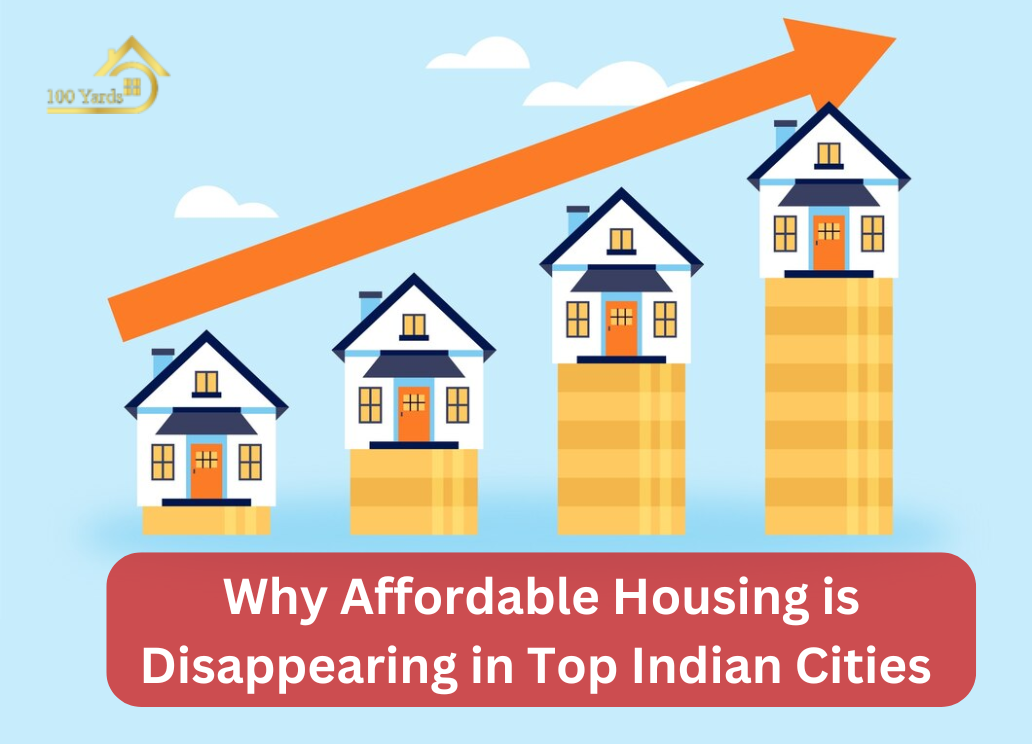As property consultants and real estate advisors in Bangalore, we at 100 Yards are deeply concerned about the disappearing landscape of affordable housing in top Indian cities. In this blog post, we shed light on the challenges facing affordable housing and explore potential solutions to address this pressing issue.
Challenges to Affordable Housing
Urbanization and Population Growth
With rapid urbanization and population growth, the demand for housing in Indian cities like Bangalore has skyrocketed. However, the supply of affordable housing fails to keep pace, leading to an imbalance in the market.
Land Scarcity and Soaring Land Prices
The scarcity of land in prime locations coupled with soaring land prices makes it increasingly challenging for developers to undertake affordable housing projects. As a result, affordable options become scarce, pushing prices further out of reach for many homebuyers.
Government Policies and Regulations
While government initiatives like the Pradhan Mantri Awas Yojana aim to promote affordable housing, bureaucratic hurdles and ambiguous regulations often hinder their effective implementation. The lack of clear guidelines on land use and zoning further complicates the situation, limiting the development of affordable housing projects in desirable areas.
Dominance of Luxury Housing Projects
The rise of luxury and premium housing projects exacerbates the affordability crisis by squeezing out affordable options from the market. Developers, incentivized by higher profit margins, prioritize high-end projects over affordable ones, leaving a gap in the market for middle and lower-income homebuyers.
Implications for the Housing Market
Exclusion of Middle and Lower-Income Homebuyers
The disappearance of affordable housing options excludes middle and lower-income homebuyers from the housing market, perpetuating inequality and widening the gap between the rich and the poor.
Shifting Preferences and Demand Patterns
The affordability crisis has led to shifting preferences and demand patterns among homebuyers. Many are forced to compromise on location, size, or quality of housing, leading to dissatisfaction and frustration.
Economic and Social Ramifications
The lack of affordable housing has far-reaching economic and social ramifications. It affects job opportunities, economic growth, and overall quality of life, posing significant challenges for sustainable urban development.
Addressing the Crisis: Solutions and Interventions
Collaborative Efforts Among Stakeholders
Addressing the affordability crisis requires collaborative efforts among government agencies, developers, financial institutions, and other stakeholders. By working together, we can develop holistic solutions that address the root causes of the problem.
Streamlining Approval Processes
Streamlining approval processes for affordable housing projects can expedite their development and reduce costs for developers. Clear guidelines and transparent procedures can encourage more developers to invest in affordable housing.
Providing Financial Incentives for Developers
Financial incentives such as tax breaks, subsidies, and grants can make affordable housing projects more financially viable for developers. By providing incentives, we can encourage developers to prioritize affordable housing over luxury projects.
Promoting Innovative Construction Technologies
Promoting innovative construction technologies such as prefabrication and modular construction can reduce construction costs and speed up the delivery of affordable housing units. These technologies offer a more efficient and sustainable approach to housing development.
Exploring Alternative Housing Models
Exploring alternative housing models such as co-living spaces, micro-apartments, and community land trusts can offer affordable and sustainable housing solutions for urban dwellers. These models prioritize affordability, community engagement, and environmental sustainability.
The Road Ahead: Advocating for Affordable Housing
Commitment to Inclusive and Accessible Housing Solutions
As property consultants and real estate advisors at 100 Yards, we remain committed to advocating for inclusive and accessible housing solutions that cater to the diverse needs of urban residents. We believe that everyone deserves a safe, decent, and affordable place to call home.
Role of 100 Yards as Advocates for Change
We are dedicated to working with policymakers, developers, and other stakeholders to address the affordability crisis and create a more inclusive housing market. Through our expertise, insights, and advocacy efforts, we strive to make a meaningful impact on the housing landscape in Bangalore and beyond.
Expert Insight & Recommendations for 100 Yards – Rohit Singh MD
Collaborative efforts and streamlined approval processes are crucial in tackling the affordability crisis. By providing financial incentives and promoting innovative construction technologies, we can pave the way for a more inclusive housing market.
Conclusion
The disappearance of affordable housing in top Indian cities presents a formidable challenge that requires urgent action and collaboration from all stakeholders. By working together, we can overcome the barriers to affordable housing and create a more equitable and sustainable housing market for future generations.
Vision for a More Inclusive Housing Market
Our vision is a housing market where everyone has access to safe, decent, and affordable housing options. We are committed to turning this vision into reality through our advocacy, partnerships, and innovative solutions.
As property consultants and real estate advisors, we invite you to join us in our mission to make affordable housing a reality for all. Together, we can build a better future for our communities and create lasting change in the housing industry.

